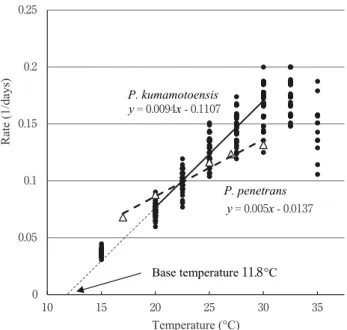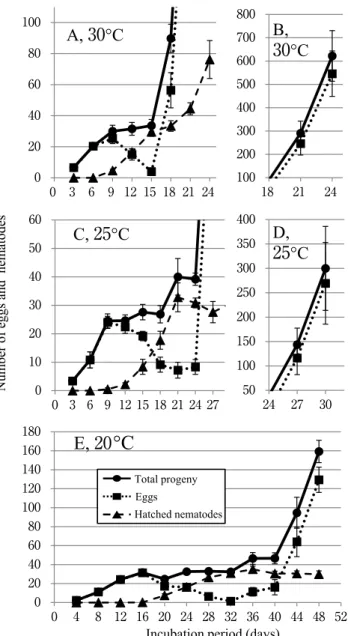1
Kyushu Okinawa Agricultural Research Center, NARO, 2421, Suya, Koshi, Kumamoto 861-1192, Japan
2
Faculty of Agriculture, Ryukoku University, 1-5 Yokotani, Seta- oecho, Otsu, Shiga 520-2194, Japan
*Corresponding author, e-mail: uesugik@affrc.go.jp
[Original Article]
Effect of temperature on the development of Pratylenchus kumamotoensis
Kenta Uesugi 1 , * and Hideaki Iwahori 2
Development of Pratylenchus kumamotoensis eggs was observed in distilled water at 15 – 35 ºC. Egg developmental duration was shortest at 32 . 5 ºC ( 5 . 6 days) and longest at 15 ºC ( 28 days). Base temperature and thermal constant estimated from data between 20 ºC and 30 ºC were 11 . 8 ºC and 108 degree-days, respectively.
Population development from a single female inoculated to chrysanthemum was observed at 20 , 25 and 30 ºC.
Pratylenhus kumamotoensis reproduced bisexually and the number of total progeny from the inoculated female sharply increased 15 – 18 days after inoculation (dai) at 30 ºC, 24 – 27 dai at 25 ºC and 40 – 44 dai at 20 ºC, indicating onset of oviposition by next generation females. These results indicated that P. kumamotoensis is closer to tropical or subtropical plant-parasitic nematodes in thermal requirements rather than to temperate species such as P. penetrans . Nematol. Res. 46 ( 2 ) 59 – 63 ( 2016 ).
Key words: base temperature, chrysanthemum, lesion nematode, thermal constant.
INTRODUCTION
Pratylenchus kumamotoensis Mizukubo et al. is a nematode pest of chrysanthemum, causing root lesions, defoliation of lower leaves and stunting of stems (Mizukubo et al., 2007 ; Sugimura and Kawasaki, 2008 ).
The species was a dominant lesion nematode in chrysanthemum fields in the Kyushu and Okinawa region of Japan (Uesugi et al., 2009 ). Another major chrysanthemum nematode pest, P. penetrans, was also distributed in this region, and some fields are infested with both species. Symptoms caused by the two species are similar to each other (Kobayashi, 1995 ; Sugimura and Kawasaki, 2008 ). However, the host range of P.
kumamotoensis is narrow compared to polyphagous P.
penetrans, while the reproductive rate of P.
kumamotoensis on chrysanthemum was considerably higher than P. penetrans (Uesugi et al., 2011 ). These data suggested that chrysanthemum nematode control in southern Japan needs to target the two Pratylenchus species with rather different host range and reproductive potential.
In addition to reproductive characteristics, a possible difference between P. kumamotoensis and P. penetrans
is thermal requirements. Pratylenchus penetrans is a temperate species with low base temperature for development (Mizukubo and Adachi, 1997 ). Actually, P.
penetrans is regarded as an important pest species in relatively cool areas of Japan (Gotoh, 1974 ). On the other hand, P. kumamotoensis is dominant in the southern Kyushu and Okinawa region, overlapping the distribution of important tropical or subtropical species such as M.
incognita and P. coffeae (Koga, 1992 ; Teruya, 1992 ).
Pratylenchus kumamotoensis could be adapted to higher temperature conditions than P. penetrans. Temperature and the rate of nematode development are usually linearly related (Trudgill, 1995 ). Base temperature, which is the lower temperature limit for development, is estimated by the temperature axis intercept of the linear regression for developmental rate at different temperatures. Thermal constant, which is measured as the reciprocal of the slope of the linear regression line, can be used to estimate the duration of development at a cer t ain temperat u re. Dat a on these ther mal characteristics of pest nematodes are important to predict their generation time, population dynamics, and resulting crop damage.
The purpose of this study is to elucidate base
temperature and thermal constant of P. kumamotoensis
development, which gives insight into temperature
adaptation of the species. To calculate base temperature
of the species, we examined the duration of the egg stage
in distilled water. We also conducted time-course
(trial 1 and 2 ). To estimate base temperature (developmental zero, ºC) and thermal constant (effective accumulative temperature, degree-days), we conducted regression analysis of developmental rate (= 1 /egg developmental duration) data from 20 . 0 to 30 . 0 ºC, where decrease in the egg hatch rate (Table 1 ) or developmental rate (Fig. 1 ) was not observed. All data from two trials were pooled in the regression analysis. Statistical analysis was conducted using JMP 12 (SAS Institute).
Effect of temperature on life cycle duration of P.
kumamotoensis (Experiment 2 ):
D u r a t io n of t he n e m a t o d e l i fe c ycle i n chrysanthemum roots was estimated from time-course change in a number of progenies from a single female.
Nematode isolate and culturing methods were the same as experiment 1 . Nematodes were extracted from soil of the pot using a Baer mann f unnel technique.
Approximately 7 cm long cuttings of chrysanthemum Jimba were put in a beaker filled with tap water at room temperature until a few centimeter-long roots emerged. A single mature female of P. kumamotoensis was placed on the root surface of a cutting on a 9 cm diameter petri dish. The root was then adequately covered with autoclaved sand and moistened by tap water. After overnight incubation at 25 ºC, roots of the cutting were washed to remove females that failed to penetrate roots. Then, the cutting was planted in a glass vial ( 3 cm diameter × 7 . 5 cm height) covered with autoclaved sand and kept in an incubator at test temperatures, 20 , 25 or 30 ºC. The day of transplanting was defined as day of inoculation (= 0 days after inoculation (dai)) in this experiment. Liquid fertilizer (NPK = 0 . 006% : 0 . 01% : 0 . 005% ) was added at 1 . 0 ml ( 25 and 30 ºC) or 0 . 5 ml ( 20 ºC) to each cutting weekly.
observations of population development from single females in chrysanthemum roots to examine the effect of temperature on the duration of a life cycle.
MATERIALS AND METHODS
Effect of temperature on egg developmental duration of P. kumamotoensis (Experiment 1 ):
An isolate of P. kumamotoensis, which was derived from a single female originally collected from the rhizosphere of chrysanthemum in Kanoya City, Kagoshima Prefecture, Japan, was used. Nematodes were maintained in chrysanthemum Jimba pot culture in a greenhouse and extracted from chrysanthemum roots using a blender-Baermann funnel technique. A gravid female was picked with an insect pin and put in a 2 cm diameter glass dish filled with distilled water. The dish was kept in an incubator at 25 ºC and checked for oviposition later in the day ( 1 – 7 h after pickup) and on the next day ( 14 – 19 h after pickup). If oviposition was observed, the female was removed from the glass dish.
Then, the dishes containing egg(s) were placed in an incubator (Bio multi incubator LH- 30 - 8 , Nippon Medical
& Chemical Instruments Co., Ltd.) at the test temperatures (Table 1 ). The dishes were replenished with distilled water as needed and observed two to three times in a day at 20 . 0 – 35 . 0 ºC or one to two times in a day at 15 . 0 ºC. The observation was continued until hatch was not observed in three consecutive days after peak of hatch at 20 . 0 – 35 . 0 ºC or continued to 40 days at 15 ºC. Egg developmental duration was calculated from estimated oviposition time (midpoint between the observation of laid egg and the previous observation) and estimated hatching time (midpoint between the observation of hatched juvenile and the previous observation).
Observation at each temperature was examined twice
Table 1 . Egg duration (days) of Pratylenchus kumamotoensis under different temperature conditions.
Temperature (ºC)
Trial 1 Trial 2
Number of
eggs Hatched
(Hatching rate) Egg duration
a(days) Number of
eggs Hatched
(Hatching rate) Egg duration
a(days) 35 . 0 101 7 ( 7 %) 7 . 3 ± 0 . 30 80 8 ( 10 %) 6 . 7 ± 0 . 45 32 . 5 80 64 ( 80 %) 5 . 6 ± 0 . 05 46 32 ( 70 %) 5 . 7 ± 0 . 08 30 . 0 103 84 ( 82 %) 6 . 1 ± 0 . 05 45 36 ( 80 %) 5 . 8 ± 0 . 08 27 . 5 98 67 ( 68 %) 6 . 8 ± 0 . 07 49 46 ( 94 %) 6 . 8 ± 0 . 07 25 . 0 101 67 ( 66 %) 8 . 3 ± 0 . 08 48 42 ( 88 %) 7 . 6 ± 0 . 09 22 . 5 80 58 ( 73 %) 9 . 9 ± 0 . 11 53 45 ( 85 %) 10 . 0 ± 0 . 10 20 . 0 89 63 ( 71 %) 13 . 9 ± 0 . 11 50 37 ( 74 %) 13 . 0 ± 0 . 14 15 . 0 80 17 ( 21 %) 28 . 0 ± 0 . 53 77 24 ( 31 %) 26 . 7 ± 0 . 36
a


